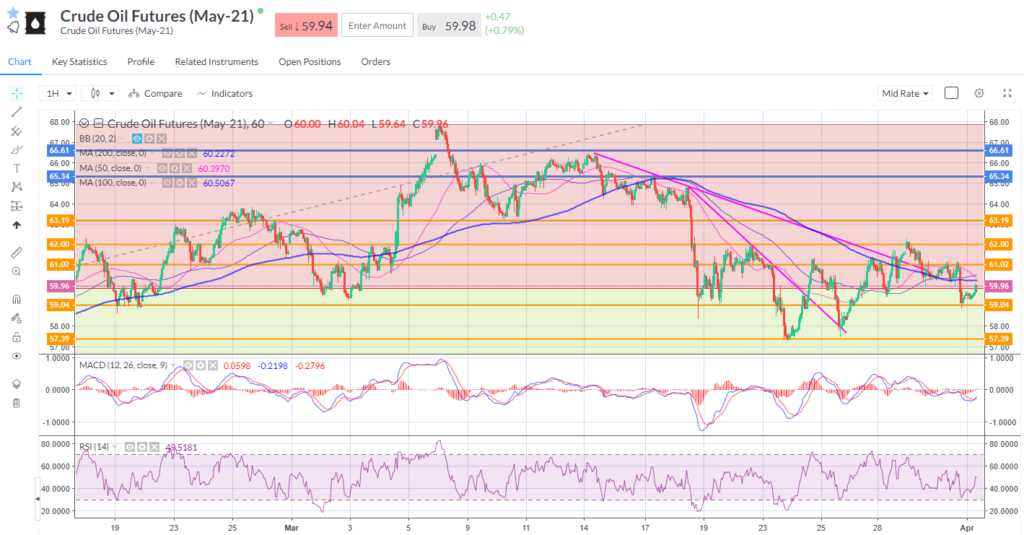
Thursday Apr 1 2021 08:11

4 min
In Pittsburgh, Pennsylvania, Joe Biden announced another massive ‘once-in-a-generation’ economic spending package barely weeks after a $1.9tn Covid relief bill. His $2tn+ infrastructure plan envisages a big, bold splurge on improving multiple areas of the economy. It’s another c10% of GDP, on top of the 10% added by his Covid bill and about the same added last year. This time, the package will be funded by tax rises, however these will be phased in over 15 years and it’s hard to see how the spending will not add to the deficit. The plans are already facing criticism on multiple fronts (too much, too little, don’t raise taxes, raise them even more!).
European markets trade broadly higher on the first trading day of the quarter after solid opening three months to 2021. The FTSE 100 moved a little higher this morning but remains well within its range for the year, and it 4% higher in 2021. The DAX trades above 15k and is +7% for the year – most of its exposure is to outside Germany, so it’s benefiting from the recovery in Asia and US. Yesterday the S&P rallied 0.9% for a fresh intra-day high just 5 points below 4,000, before closing up 0.4% to finish the quarter 5.8% ahead. The Dow was weaker on the day but nevertheless rose 7.8% for the quarter. For both, their performance in March was the best monthly gain since November.
Global manufacturing activity is starting to look good. Italy’s factory activity has grown at the fastest pace in over 20 years, according to this morning PMI. France’s March PMI showed the sharpest rise in manufacturing output since September 2000, albeit before the nation’s third lockdown was announced. The report also notes that the headline figure was inflated by a sharp downturn in vendor performance, which in normal times is a sign of health but these are not normal times and is more about supply chain problems and raw material shortages. Inflationary pressures were also evident as the scarcity of raw materials forced up cost burdens at the fastest rate since May 2011. The rate of inflation for prices charged to consumers was the strongest since June 2011. The Chicago PMI yesterday hit the best in two and a half years. The Bank of Japan’s headline Tankan index for big manufacturers’ sentiment improved to +5 in March from -10 in December. China’s manufacturing recovery continues, albeit at a slower pace last month.
Deliveroo shares are lower again after an ignominious crash on day one, sliding over 1% in early trade to 283p. ROO ended its first day of trading at 287p, down 26% from its list price. Several reasons are behind the poor performance. In addition to the failure to bring several large funds on board, the dual class share structure, regulatory uncertainty, general profitability concerns and a miscalculation by the bankers on the pricing in relation to wider demand in the market, it also looks like some hedge funds shorted the stock aggressively from day one. Not all stocks have a happy start to life on the stock market – just ask Tim Steiner or Mark Zuckerberg – but it’s not a great advert for London as a destination for tech listings.
Next shares are higher after it raised its full year profit outlook by £30m to £700m. Whilst the end of lockdown is two weeks later than expected, management said the profit lost from those additional two weeks has been offset by the benefit of the extension of business rates relief announced in March. In the first eight weeks of the year, online sales were stronger than expected, rising more than +60% on two years ago.
Bitcoin trades a little under $59k following news that Goldman Sachs is set to offer crypto services. Yesterday the bank said it is looking to offer a “full spectrum” of investments in Bitcoin and other digital assets, “whether that’s through the physical Bitcoin, derivatives or traditional investment vehicles”.
Gold popped up off the support at the $1,685 area to trade around the $1,715 marker. WTI has tested the $59 support ahead of the OPEC+ meeting, at which members are expected to maintain the current level of output curbs and Saudi Arabia will stick to its additional 1m bpd cut. The usual sources are already hitting the wires with ministers said to be discussing a range of options that include a rollover of cuts and a gradually increase in output at a maximum of 500k bpd, presumably on a monthly basis. US crude inventories unexpectedly fell as refiners ramped up activity to meet demand – gasoline demand is above where it was last year.

